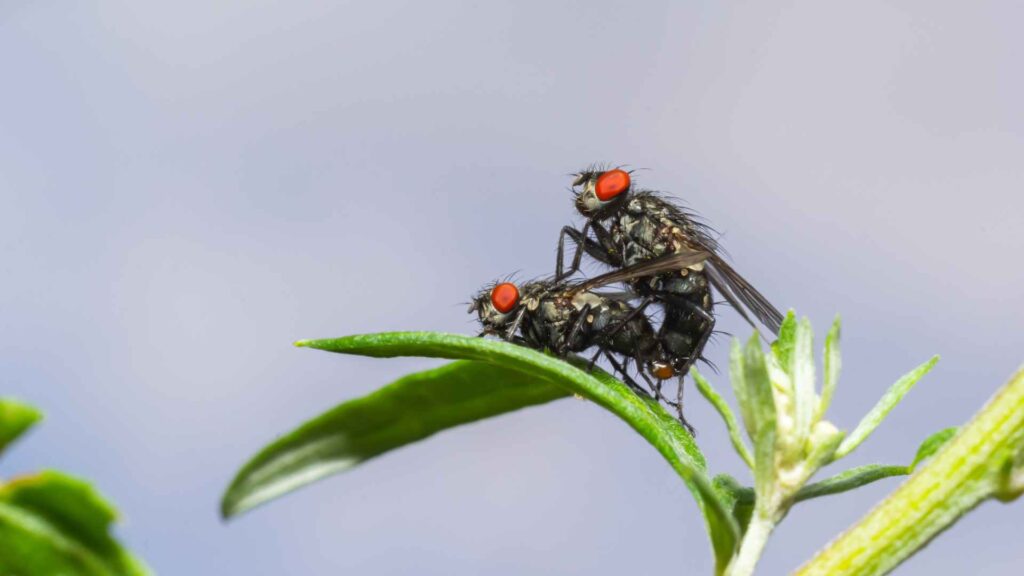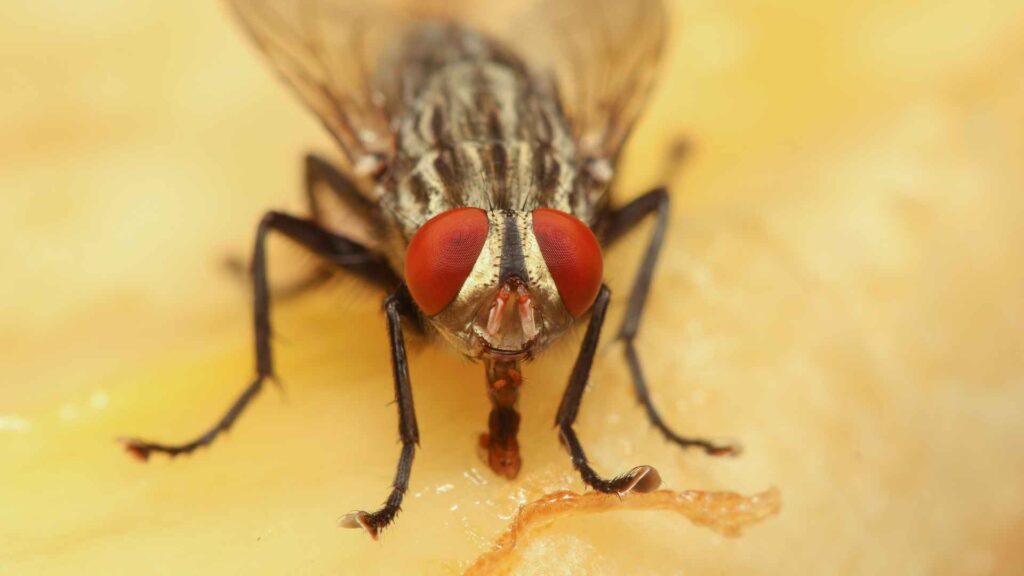Table Of Content
ToggleFlesh flies can indeed be a considerable nuisance, often buzzing around homes or businesses and leaving occupants wondering how to eliminate them. As a pest control expert, I aim to offer a comprehensive guide on not only understanding the behavior and habits of flesh flies but also providing effective strategies for their elimination.
Flesh flies are metallic-colored flies with a grey or black body. They’re attracted to decaying organic matter, making them a common problem in areas with garbage, animal waste, or dead rodents. These flies can lay hundreds of eggs at a time, and their rapid reproduction makes controlling infestations crucial.
Flesh flies not only create a buzzing annoyance, but they also pose health risks.
They can transmit diseases like E. coli and Salmonella by spreading bacteria on surfaces they land on.
Additionally, flesh fly infestations can negatively impact livestock and pet health.

Spotting a surge in fly activity around your property? It might be more than a nuisance – it could be flesh flies. Here’s how to identify these pests and their unwelcome presence:
Don’t Be Fooled by Flies: While houseflies are a common annoyance, flesh flies can be distinguished by their metallic coloring and attraction to decaying materials. Early detection is crucial, for effective pest control for flies in your house.
Contact us for a customized fly-free pest plan.
Flesh flies are more than just a buzzing nuisance; they pose a health threat to your family and pets. These flies can transmit various diseases through contaminated surfaces. Here’s why controlling a flesh fly infestation is important:
By taking action to eliminate flesh flies, you’re safeguarding the well-being of your loved ones and creating a healthier environment.

Here’s a multi-pronged approach to effectively eliminate flesh flies:
Important Note: Insecticides should be a last resort due to potential safety concerns. Always consult a pest control professional for safe and effective application. We can recommend the appropriate insecticide and ensure its proper use to target flesh flies while minimizing risks to you, your family, and pets.
Here are some examples of commercially available insecticides that may be effective against adult flesh flies, depending on the specific product and the severity of the infestation:
Remember: Always follow the manufacturer’s instructions on the product label carefully. Improper use of insecticides can be hazardous.
Beneficial Nematodes: These microscopic warriors are nature’s answer to flesh fly larvae. These tiny worms are natural predators that seek out and parasitize maggots, effectively reducing the next generation of flesh flies.
Beneficial nematodes can be applied to areas with maggot activity for targeted control. This eco-friendly approach offers a safe and effective way to manage flesh fly populations.
Schedule a quick consultation for targeted fly control.
Winning the battle against flesh flies isn’t just about eliminating the current infestation; it’s about preventing their return. Here are some key strategies for long-term management:
Don’t let your guard down after eliminating the initial infestation. Conduct routine inspections of your property, especially around potential breeding sites like garbage cans, compost bins, and areas frequented by pets.
Look for adult flies, maggots, or a foul odor – all signs of a potential comeback. Early detection allows for swift action to nip a new infestation in the bud before it explodes.
Knowledge is power, especially in the fight against flesh flies. Educate everyone in your household or workplace about proper sanitation practices that can prevent attracting these pests in the first place. Here are some key points to emphasize:
Explore safe pest control for homes with infants.

As a pest control expert, I recommend implementing an integrated pest management (IPM) approach for effective flesh fly control.
This combines sanitation measures, physical exclusion methods, and, when necessary, targeted control methods like insecticides or biological controls.
By combining these strategies with ongoing vigilance, you can maintain a fly-free environment and safeguard the health of your family, pets, and livestock.
Flesh flies typically go away within a few days to a week if the conditions that attracted them are addressed, such as removing sources of decaying organic matter and maintaining good sanitation practices.
Flesh flies are attracted to decaying organic matter like garbage, dead animals, and rotting food. They are also drawn to moist environments, making areas with standing water or high humidity more appealing to them.
You may have many flesh flies due to the presence of decaying organic matter in or near your home, such as garbage bins, compost piles, or dead animals. Additionally, if your home has high humidity or moisture issues, it can create a conducive environment for flesh flies to thrive and reproduce.
Flesh flies may suddenly appear due to an increase in decaying organic matter, such as a pile of rotting food or a dead animal nearby. Changes in weather, such as a sudden rise in temperature, can also accelerate the decomposition process and attract more flesh flies to the area.
References
http://www.idph.state.il.us/envhealth/pcfilthflies.htm#:~:text=House flies typically lay eggs,to undergo the pupal stage.
https://en.wikipedia.org/wiki/Nematode
Your trusted pest control experts in Southern California. Keeping your neighborhood pest-free!